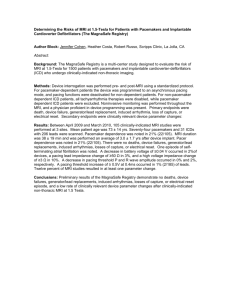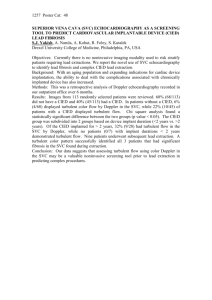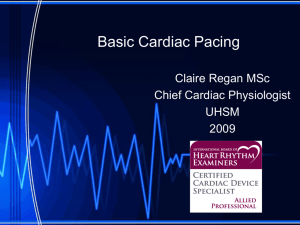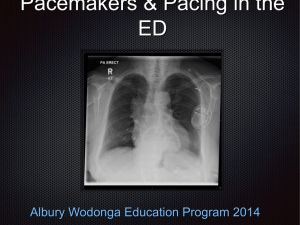Management of RT patients with implanted cardiac devices: From recommendation to implementation
advertisement
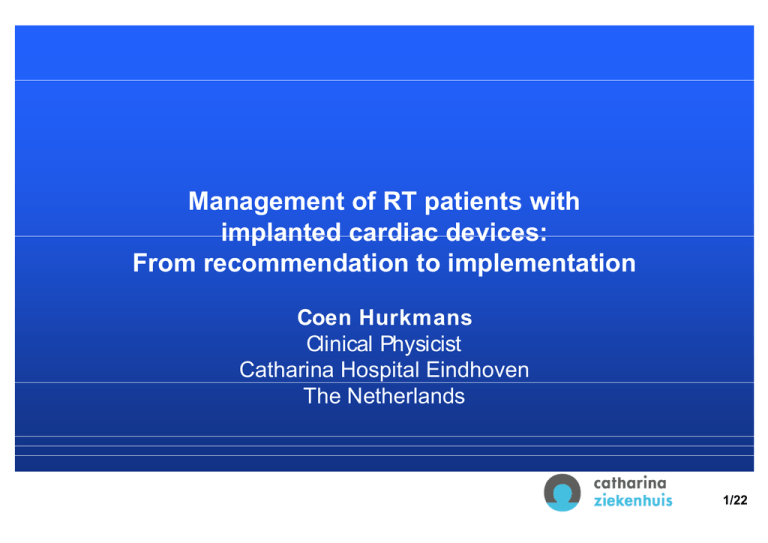
Management of RT patients with implanted cardiac devices: From recommendation to implementation Coen Hurkmans Clinical Physicist Catharina Hospital Eindhoven The Netherlands 1/22 Outline CIED relocation. An option? CIED malfunction and clinical significance Pacing dependency ICD therapy. On or off? Patient management The patients perspective Prior to treatment During/after treatment 2/22 CIED relocation. An option? CIED implantation risks: 1-2% of patients serious complications (0.3% mortality) requiring acute thoracic surgery (Wilkoff et al., Heart Rhythm 2009;6:10851104). CIED re-implantation on other side risks: infection (0.4% 4.0%) which necessitates removal of the device pneumothorax (0.8%-1.7%) (de Bie et al., Heart Rhythm 2012;9:494-498). Elective replacement of a CIED: 5.8% serious complications (Gould et al. JAMA 2006;295:1907-1911 ) Chance of infection increases with subsequent CIED replacement (Borleffs et al., Pacing Clin Electrophysiol 2010;33:1013-1019). 3/22 Types of failure in relation to clinical significance Pacing pulse All amplitude deviations of more than 25%. Complete loss of signal (POF). All pulse duration changes of more than 25%. The pulse energy has to be sufficiently high to stimulate the heart. Usually, the pulse energy (pulse amplitude times pulse duration) is programmed at an approximately 50% higher value than the lower threshold value to stimulate the heart of an individual patient. An energy drop of 25% will therefore probably not be noticed by the patient. However, it might indicate that the pacemaker has been damaged. Hurkmans et al., Radiother Oncol 2005;76:93-98 4/22 Types of failure in relation to clinical significance Pacing frequency All frequency changes of more than 10% before or after irradiation (POF). Inhibition during irradiation only shorter than 5 s. Inhibition during irradiation only longer than 5 s. More than a single inhibition before or after irradiation (POF). If the pacing frequency becomes too high, ventricular tachycardia may occur which can lead to a life threatening decrease of blood pressure (Zweng et al., Angiology 2009;60:509-512.). Inhibitions during irradiation might be due to the direct irradiation of the pacemaker and might not be seen if the pacemaker is placed outside the field. Frequency changes or inhibitions before or after irradiation indicate that the pacemaker is damaged. A pacemaker technician should inspect the pacemaker. Hurkmans et al., Radiother Oncol 2005;76:93-98 5/22 Types of failure in relation to clinical significance Sensing threshold changes larger than 25%. Telemetry Temporary loss of telemetry. Permanent loss of telemetry (POF). Miscellaneous Battery problems Lead impedance changes Soft errors / Reset to factory settings Erroneous VT/VF detection Hurkmans et al., Radiother Oncol 2005;76:93-98 6/22 Types of failure in relation to clinical significance Soft errors - Single event upsets caused by neutrons 18 MV neutron dose 14-20 times higher than for 10 MV beam! Hashii et al., IJROBP 2012 in press 7/22 Types of failure in relation to clinical significance neutron dose 1-9 mSv/Gy Hasimoto et al, Radiat Oncol 2012, 7:10 8/22 Pacing dependency It is obvious that a complete loss of pacing ability will have major implications for pacing dependent patients. If the underlying heart rhythm is not sufficient, the patient will require cardiopulmonary resuscitation. Often, this is followed by external pacing through intravenously placed leads or external electrodes connected to a temporary external pacemaker. 9/22 Pacing dependency A commonly used definition of pacing-dependency is: Patients who have no intrinsic or escape rhythm and who may become symptomatic (syncope, arrhythmia, serious injury or even sudden death) when the CIED pacing function fails. (Hauser RG, et al. Heart Rhythm 2006;3:640-644., Lelakowski et al. Cardiol J 2007;14:83-86., Korantzopoulos et al. Europace 2009;11:1151-1155.) The incidence of pacing-dependency in a mixed CIED population is around 10%. 10/22 Tachycardia therapy: ICD therapy off? In a study of Borleffs et al., approximately 50% of all ICD patients had ICD therapy at least once in a study with 8 years follow-up (Borleffs Eur Heart J 2009;30:1621-1626.). The moment of therapy is unpredictable, however, assuming the chance of this therapy is constant, ICD therapy occurring at least once during a 6 week course of radiation treatment can be calculated at approximately 0.7%. Deactivation of the ICD shock function during the entire radiation therapy period would lead to a similar chance of withholding a potentially lifesaving shock. 11/22 Tachycardia therapy: ICD therapy on? In the ICD population, approximately 10-20% of patients experience an unnecessary shock within a 5 year follow-up period. It has been reported that these patients have a loss in their quality of life and may develop psychological complaints as a result (Bostwick and Sola., Heart Fail Clin 2011;7:101-108) Delivery of an unnecessary shock during RT is highly undesirable. 12/22 Tachycardia therapy: ICD therapy on or off? Off: 0.7% chance on withholding lifesaving shock On: Chance due to RT on unnecessary shock Dutch guideline: Off during each fraction (0.005% chance on withholding lifesaving shock) 13/22 Patient management Tondato F, Ng DW, Srivathsan K et al. Radiotherapy-induced pacemaker and implantable cardioverter defibrillator malfunction. Expert Rev Med Devices 2009;6:243-249. Extra items: pacing dependency cardiac equipment 14/22 Patient management Wadasadawala T, Pandey A, Agarwal JP et al. Radiation therapy with implanted cardiac pacemaker devices: a clinical and dosimetric analysis of patients and proposed precautions. Clin Oncol (R Coll Radiol ) 2011;23:79-85. Pacing independent Extra items: pacing dependency definition 15/22 Patient management Hudson F, Coulshed D, D'Souza E et al. Effect of radiation therapy on the latest generation of pacemakers and implantable cardioverter defibrillators: A systematic review. J Med Imaging Radiat Oncol 2010;54:53-61. Treatment Equipment to be maintained by the department 1 Cardiac monitoring device (ECG); 2 crash cart including CPR devices; and 3 hospital defibrillator with external pacemaker capacity. Pacemaker and defibrillator patients Non-pacemaker dependant patients 1 Treatment may be undertaken as per dept protocol. 2 Regular device checks are advised after every session ideally, at least weekly. 3 TLDs performed day 1 to check dose received by the pacemaker. Extra items: pacemaker vs ICD Pacemaker dependant patients 1 Cardiac monitoring (ECG) is essential during every treatment session by appropriately trained personnel (with ability to respond to any arrhythmic event). 2 Device checks are advised after every session. 3 If an extreme bradycardia occurs, staff should be prepared to resuscitate the patient using external pacing as required (as a bridge to transvenous pacing and device replacement). 4 TLDs performed day 1 to check dose received by the pacemaker. ICD patients 1 Use the defibrillator programmer to disable antitachycardia therapy during treatment. 2 Cardiac monitoring (ECG) is essential during every treatment session by appropriately trained personnel (with ability to respond to any arrhythmic event). Monitoring must start as soon as the anti-tachycardia therapy is switched off and continue until the antitachycardia therapy is switched back on after the treatment session. 3 Device checks are advised after every session. 4 If an extreme bradycardia occurs, staff should be prepared to resuscitate the patient using external pacing as required. 5 TLDs performed day 1 to check dose received by the ICD. 16/22 Extra item : the patients perspective Dutch patient focus group: CIED management problems related to radiation therapy of low interest. They are dealing with much more serious health care related problems. Some appreciated receiving detailed information while others did not wish to be informed. The treating radiation oncologist and cardiologist should together decide and present the best course of individualised treatment to them. 17/22 patient management: patient oriented risk categories The patient s risk is not equal to the risk of a CIED defect The chance on CIED malfunction mainly increase with dose and are not accurately known A practical guideline will be easier to implement < 2 Gy 2-10 Gy > 10 Gy pacing-independent Low risk Medium risk High risk pacing dependent Medium risk Medium risk High risk 18/22 Prior to treatment An estimation of the CIED dose should be made by the responsible clinical physicist, which may be supported by a measurement or calculation. The accuracy needs to be high enough to reliably determine the patient risk category. 19/22 Prior to treatment No heterogeneity correction for the density of the CIED should be made, as this has not been done in the vast majority of articles published about CIED dose in relation to CIED defects. Fig from: Gossman MS et al, J OF APPL. CLIN. MED. PHYS.11 (1), 2010 20/22 During and after treatment ICD might be left on after first fraction if intra-cardiac electrogram during first session is made. Medium/high risk: personnel trained in reanimation and a pacemaker technologist and/or cardiologist must be able to reach the patient within 10 minutes of a request in case of an emergency. Extra item: personnel training 21/22 acknowlegdements AAPM annual meeting scientific committee AAPM TG 203 members Dutch TG on management of CIED patients Academic fund Catharina Hospital RT department 22/22
